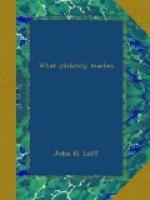[Illustration: Stamp, “Shanghai LPO”, 80 cash]
[Illustration: Stamp, “Nicaragua”, 1 centavo]
[Illustration: Stamp, “Estados Unidos de Colombia”, 50 cents]
[Illustration: Stamp, “Venezuela”, 5 c’s]
[Illustration: Stamp, “State of North Borneo”, 18 cents]
One of the stock arguments advanced in favor of philately, by those who think it needs other excuse than the entertainment it affords, is that it teaches geography. This is undoubtedly true, and, as if in support of the argument, several countries have given us what might be called map stamps. Of late years, it has become customary for countries to exploit their attractions by issues of “picture” stamps, many of which show views of local scenery. One of the first in this line came from North Borneo, showing a view of Mt. Kimbal, a celebrated volcano of the island. Congo has given us two pictures which are microscopic gems of art. The first is a view of the railroad crossing the Mopoxo river and the second the Falls of Inkissi. British Guiana has recently shown us two of her natural wonders, Mount Roraima, a great table-topped mountain, and the Kaiteur Falls. New Zealand has an extensive series of views, one of the most striking of which is Mount Cook. Among the latest of these attractive issues is one from Tonga, which includes a picture of a wonderful work of the pre-historic inhabitants of those islands, a tri-lithon, believed to have been erected as a burial place and monument of a chieftain. In its arrangement and massive simplicity it is suggestive of the Druidic ruins of other lands.
[Illustration: Stamp, “Congo”, 50 centimes]
[Illustration: Stamp, “Congo”, 25 centimes]
[Illustration: Stamp, “British Guayana”, 1897, 1 cent]
[Illustration: Stamp, “British Guayana”, 1897, 2 cents]
[Illustration: Stamp, “New Zealand”, 5 pence]
[Illustration: Stamp, “Toga”, 3 d.]
[Illustration: Stamp]
Crowns and post-horns figure on many stamps and both are significant of the authority and purpose of these seemingly trifling bits of paper. An interesting combination of these two emblems is found on one of the newspaper stamps of Hungary. In this case the crown is not merely a creation of the artist’s fancy but the historic crown of Saint Stephen, the “iron crown of Hungary,” so called because it has within its rim an iron band said to be made from one of the nails of the cross.
In all these subjects of thought I have mentioned only a few examples under each head. The number might be multiplied many times, did I not fear to weary you.




